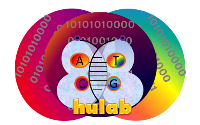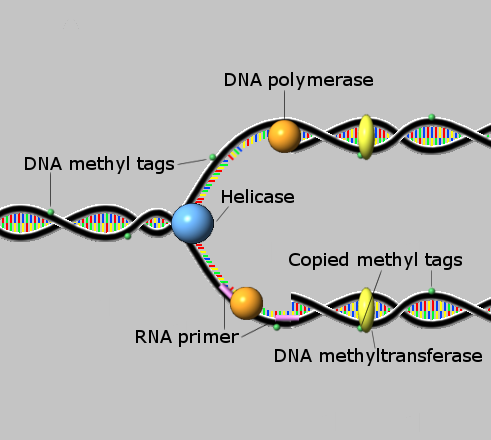Epigenetics and Inheritance

During mitosis DNA is unwound, split, and copied into two new strands. DNA methyltransferase enzymes are responsible for preserving methylation patterns through mitosis.
Cell Division and Epigenetic Inheritance:
DNA is replicated in a semi-conservative manner. Various DNA replication machinery preserve genetic and epigenetic information. DNA methylation patterns have been thought to be maintained through mitosis by DNA methyltransferase.
Inheritance of histones and their tags have been disputed because DNA must be unwound before replicated. Structural modifications can occur when the newly replicated DNA rewraps around histones differently than in the original strand. It is thought that chromatin structure is not inherited but rather influenced by the parent cell.
Current mitotic modeling and simulation methods attach histones in one of three ways, in a random fashion where both the parent and daughter cells have both original and new histones, a semi-conservative method where new and old histones are divide evenly and attached to both strands, and an asymmetric manner where one strand receives all of the original histones while the other has all new histones. [2]
Inheritance of histones and their tags have been disputed because DNA must be unwound before replicated. Structural modifications can occur when the newly replicated DNA rewraps around histones differently than in the original strand. It is thought that chromatin structure is not inherited but rather influenced by the parent cell.
Current mitotic modeling and simulation methods attach histones in one of three ways, in a random fashion where both the parent and daughter cells have both original and new histones, a semi-conservative method where new and old histones are divide evenly and attached to both strands, and an asymmetric manner where one strand receives all of the original histones while the other has all new histones. [2]
Transgenerational Inheritance:
Originally, biologists thought that a new embryo's entire genome stripped of all epigenetic marks and reprogrammed from scratch. Most marks are still thought to be removed from the new genome; however certain essential marks are thought to remain on DNA through meiosis.
Imprinting is the idea that certain epigenetic marks can escape reprogramming. Although imprinting is thought to be important for normal cellular function, certain genetic disorders such as Prader-Will syndrome and Angelman syndrome have been linked to genetic imprinting.
Imprinting is the idea that certain epigenetic marks can escape reprogramming. Although imprinting is thought to be important for normal cellular function, certain genetic disorders such as Prader-Will syndrome and Angelman syndrome have been linked to genetic imprinting.
Importance of Transgenerational Epigenetic Inheritance:
If epigenetic marks can be inherited, this could give us a better understanding on influential features for an organism’s phenotype. Experiments have found many instances of epigenetic inheritance in plants but not as many in animals. An example of this would be in the DNA methylation pattern of the CYCLOIDEA gene dictates whether the plant's dorsal petals are bilaterally symmetric to radially symmetric.
Imprinted genes generally share a few qualities that make them good candidates for transgenerational inheritance. These genes are generally found to effect cell growth, metabolism, and behavior. However, no solid conclusions have been drawn about the effects of inheriting these epigenetic marks. The strongest argument made against multigenerational epigenetic inheritance is ruling out DNA sequencing as the main driving force behind an organism’s phenotype.
It makes sense that an organism would want to pass their environmental adaptations on to the next generation. However, these type of changes would not support the relation between epigenetics and phenotype since these marks are flexible and have the ability to change in one generation's lifetime. [3]
Imprinted genes generally share a few qualities that make them good candidates for transgenerational inheritance. These genes are generally found to effect cell growth, metabolism, and behavior. However, no solid conclusions have been drawn about the effects of inheriting these epigenetic marks. The strongest argument made against multigenerational epigenetic inheritance is ruling out DNA sequencing as the main driving force behind an organism’s phenotype.
It makes sense that an organism would want to pass their environmental adaptations on to the next generation. However, these type of changes would not support the relation between epigenetics and phenotype since these marks are flexible and have the ability to change in one generation's lifetime. [3]
Resources:

